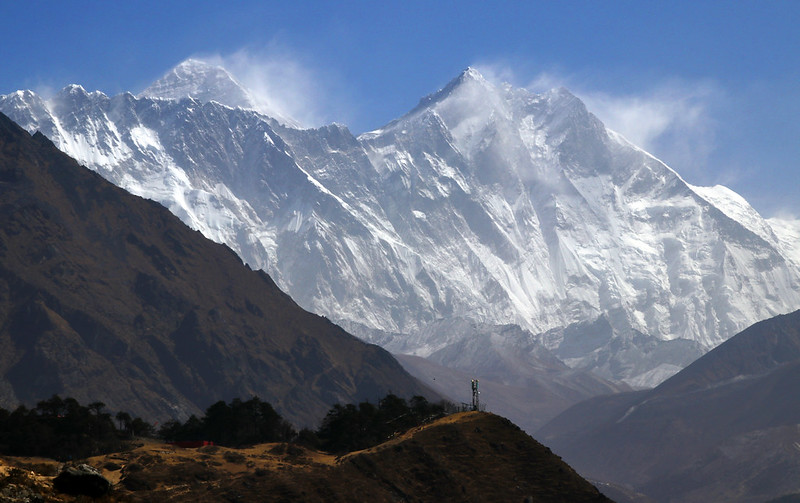Tibetans are continuously controlled through camera networks and artificial intelligence. Now, Huawei’s highest 5G base station on Mount Everest will also favor international cyber-espionage.
by Tenzin Dalha

Repressing Tibet before and after the coronavirus
Amidst fears of the coronavirus sending billions of people into lockdown around the world, China is widely expanding its surveillance network to strengthen and maintain vigilance of its entire population. It is true that such measures have proven effective during the pandemic by tracking people’s movements through cellphones, and have provided services through robots delivering food to hospitals, facial recognition cameras tracking people’s temperature, and mechanical drones enforcing lockdown for quarantines. However, Chinese authorities are now putting considerable pressure on private companies to hand over sensitive data collected for anti-epidemic purposes, and some experts fear the surveillance measures implemented during the pandemic could become permanent. Attempts by the Chinese government to transform the Internet into a system of surveillance and censorship represent a fundamental threat to freedom and democracy at large.
The iron curtains on Tibet have been shut for a long time, and the entire region is off limits for free and independent visits of international media, journalists, advocates, researchers and governments and civil society representatives. The highly repressive situation inside Tibet makes it difficult to understand the scope of digital surveillance in the region. Over the years, China’s surveillance system in Tibet has been growing and evolving at an unprecedented scale. The abundance of manned and unmanned checkpoints, artificial intelligence systems, CCTV camera networks, and re-education centers under the garb of national security have added another layer of control to an already extremely restrictive and oppressed environment in Tibet.
Furthermore, the CCP is constantly upgrading its “Great Firewall of China” to monitor and limit online and offline traffic by creating its “own” Internet and limiting access to the “traditional” web. Chinese authorities in Tibet are offering large cash rewards to informants in a bid to stamp out online “subversive” activities to curb the open dissemination of information. According to a notice issued on February28 by three government departments of the so called Tibet Autonomous Region, information leading to the arrests of social media users deemed disloyal to China can fetch up to 300,000 Yuan ($42,582). People sharing political contents or commentary deemed sensitive face arrest and heavy criminal penalties.
Huawei and 5G in Tibet
The earliest signs of China’s construction of three 5G stations in Tibet were seen in January 2019, having been established at Huawei’s building, the Lhasa Post and Telecommunications school and at the office of Tibet Post groups in Lhasa. Dhoundup (name changed on request) from Lhasa said in interview with the author, “Chinese government ensures streaming quality with the capabilities of optimization for introduction of 5G, but in reality there is no much network speed difference between 5G and 4G at current.”
A week ago, Huawei, a Chinese multinational telecommunications equipment and service, teamed up with China Telecom, the Chinese state-owned telecommunication company, to set up in Tibet the world’s highest 5G base station at an altitude of 6,500 meters. 5G is the fifth generation of wireless communication technologies, enabling a new wave of innovation and offering greater bandwidth network capacity.
5G is also the next generation of cellular technology, with download speeds 10 to 100 times faster than 4g LTE networks. Lhundup (name changed on request) from Yushu Tibetan Autonomous prefecture mentioned to me that, “There is always slow network connection in Lhasa, the capital city of Tibet, Shigatse, etc. as compared to rest of Chinese cities. The speed of Internet always declines if political protests occur up within the prefecture.” Experts believe that 5G, which can support the Internet far more effectively than its predecessors, can serve a wide range of military purposes, including monitoring mountainous borders and assisting in the deployment of weapons.
Why 5G on Mount Everest?
The inception of 5G network on the summit of Mount Everest has great potential for changing the world, particularly in powering the precise monitoring for Artificial Intelligence. The ability to harness these technologies expand the scale and scope of the threat of making it easier to deploy sensors and quickly transmit high volumes of data for real time analysis. Mountainous regions that do not require such intensive communication systems have seen these systems used as surveillance tools for the State, to use against tourists as well as borderland residents of these areas.
With the introduction of 5G networks, there will be further possibility for cyberespionage, international data theft, and domestic spying out of global digital networks. China installed three hundred and fifty thousand 5G network relays—about ten times more than the United States—for enhanced geolocation. Each of these relays, equipped with an expensive network of surveillance cameras backed with facial recognition technology, has enabled authorities to track and subordinate the movement of Tibetans. Security experts, lawmakers, and intelligence officials have consistently warned about the security loopholes, and the system could be exploited by the Chinese government for espionage, presenting a potentially grave border security risk.
There needs to be concern over China’s intention to launch Huawei’s 5G networks in Tibet. It would make it easier to deploy sensors and enable quick transfer of high volumes of data for real-time analysis. Companies facilitating digital surveillance in Tibet include Alibaba, search provider Baidu, chat app operator Tencent Holdings, voice recognition company iFlyTek, and facial recognition system Sense Time. State subsidies and other government privileges make Tibet a lucrative market for these businesses to invest and employ their latest technologies. Companies operating in Tibet enjoy a highly reduced tax rate of 9% compared to the standard corporate tax rate of 25% for the rest of China.
The widespread implementation of surveillance, leading to the intrusion of privacy, could become a cause for further unrest in restrictive states. The absence of freedom and opportunities for people to vent their grievances will most likely multiply hatred, leading to even more collective anger and dissent among suppressed groups.
Inside Tibet, over the last decade, the “nets in the sky and traps on the ground” have further suppressed the fundamental freedoms of expression, movement and assembly. New and highly advanced technologies have given unrestricted and illicit power to the state security apparatus to intensify and escalate mass surveillance. Checkpoints with smart surveillance and facial recognition are present in cities and at crossings between neighboring districts and provinces. Tibetans inside their homes are tracked through their phones, and once they step outside surveillance and facial recognition technologies follow them wherever they go. The 5G network is billed as the new frontier from open communication and a globalizing community, yet in reality, it serves once again as the harbinger of closed borders, restricted populations, and a loss of privacy.
Source: Bitter Winter



